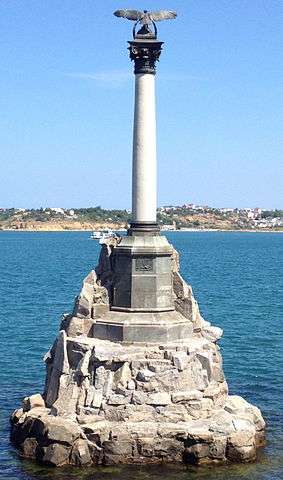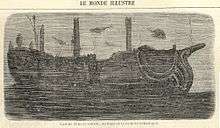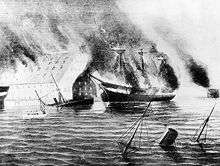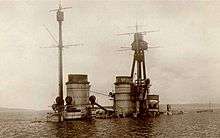Scuttling

Scuttling is the act of deliberately sinking a ship by allowing water to flow into the hull. This can be achieved in several ways—valves or hatches can be opened to the sea, or holes may be ripped into the hull with brute force or with explosives. Scuttling may be performed to dispose of an abandoned, old, or captured vessel; to prevent the vessel from becoming a navigation hazard; as an act of self-destruction to prevent the ship from being captured by an enemy force; as a blockship to restrict navigation through a channel or within a harbor; or to provide an artificial reef for divers and marine life.
Notable historical examples
Hernán Cortés (1519)
The Spaniard conquistador Hernán Cortés, who led the first expedition that resulted in the fall of the Aztec empire, ordered his men to strip and scuttle his fleet to prevent the secretly planned return to Cuba by those loyal to Cuban Governor Diego Velázquez de Cuéllar. Their success would have halted his inland march and conquest of the Aztec Empire.
HMS Sapphire (1696)
HMS Sapphire was a 32-gun, fifth-rate sailing frigate of the Royal Navy in Newfoundland Colony to protect the English migratory fishery. The vessel was trapped in Bay Bulls harbour by four French naval vessels led by Jacques-François de Brouillan. To avoid capture, the English scuttled the vessel on 11 September 1696.
Siege of Yorktown (1781)
The British sank one ship on October 10, 1781 to prevent it from getting captured by the French fleet.
Chesapeake Bay Flotilla (1814)
During the War of 1812, Commodore Joshua Barney, of the U.S. Navy, Chesapeake Bay Flotilla, sank all nineteen of his fighting vessels, to keep them from falling into the hands of the British, as he and his men marched, inland, in the defense of Washington DC.
Jan van Speijk (1831)
During the Belgian war of independence, Dutch gunboat commander Jan van Speijk came under attack from a mob of Antwerp labourers. When they forced him and his crew to surrender, he ignited a barrel of gunpowder, thus sinking his ship and killing himself and most of the crew. According to tradition, in his last words he said he'd "rather be blown up" than become a Belgian. Van Speijk went on to become a national hero in The Netherlands.
Russian Black Sea Fleet in Sevastopol (1854)

During the Crimean War, in anticipation of the Siege of Sevastopol, the Russians scuttled ships of the Black Sea Fleet to protect the harbour, to use their naval cannon as additional artillery, and to free up the ships' crews as marines. Those ships that were deliberately sunk included Grand Duke Constantine, City of Paris (both with 120 guns), Brave, Empress Maria, Chesme, Yagondeid (84 guns), Kavarna (60 guns), Konlephy (54 guns), steam frigate Vladimir, steamboats Thunderer, Bessarabia, Danube, Odessa, Elbrose and Krein. After the war, it became a technological challenge to recover the ships.
USS Merrimack/CSS Virginia (1861)

In 1861, the Federal steam frigate Merrimack was set afire in Gosport Shipyard (now Norfolk Naval Shipyard) to keep her from falling into Confederate hands. The unsuccessful attempt at scuttling enabled the Confederate Navy to raise and rebuild her as Virginia. Virginia was later sunk by the Confederates after her famous battle with USS Monitor to keep her from being taken back.
Peruvian fleet at El Callao (1881)
During the War of the Pacific, as Chilean troops entered Lima and El Callao, the Peruvian naval officer Germán Astete ordered the whole Peruvian fleet to be scuttled to prevent capture by Chile.
SS Kaiser Wilhelm der Grosse (1914)
In August 1914, SS Kaiser Wilhelm der Grosse was requisitioned by the Kaiserliche Marine and converted into an auxiliary cruiser, assigned to commerce raiding in the Atlantic. She was fitted with six 10.5 cm (4 inch) guns and two 37 mm guns. After sparing two passenger ships because they were carrying many women and children, she sank two freighters before she herself was sunk on 26 August 1914. She was caught refuelling off the shore of the then Spanish colony of Río de Oro in western Africa by the old British 6-inch gunned cruiser HMS Highflyer. Badly outgunned, the ship eventually ran out of ammunition. The crew abandoned and scuttled her. British sources at the time insisted that Kaiser Wilhelm der Grosse sank because of the damage inflicted by Highflyer.
SMS Dresden (1915)
In December 1914, the SMS Dresden was the only German warship to escape destruction in the Battle of the Falkland Islands. She eluded her British pursuers for several more months, until she put into Más a Tierra in March 1915. Her engines were worn out and she had almost no coal left for her boilers. There, she was trapped by British cruisers, which violated Chilean neutrality and opened fire on the ship. The Dresden's Executive Officer - the future Admiral Wilhelm Canaris - negotiated with the British and bought time for his shipmates to scuttle the Dresden.
Zeebrugge Raid (1918)
The Zeebrugge Raid involved three outdated British cruisers chosen to serve as blockships in the German-held Belgian port of Bruges-Zeebrugge from which German U-boat operations threatened British shipping. Thetis, Intrepid and Iphigenia were filled with concrete then sent to block a critical canal. Heavy defensive fire caused the Thetis to scuttle prematurely; the other two cruisers sank themselves successfully in the narrowest part of the canal. Within three days, however, the Germans had broken through the western bank of the canal to create a shallow detour for their submarines to move past the blockships at high tide.
German fleet at Scapa Flow (1919)

In 1919, over 50 warships of the German High Seas Fleet were scuttled by their crews at Scapa Flow following the deliverance of the fleet as part of the terms of the German surrender. Rear Admiral Ludwig von Reuter ordered the sinkings, denying the majority of the ships to the British. Von Reuter was made a prisoner-of-war in Britain but his defiant final act of war was celebrated in Germany. Though most of the fleet was subsequently salvaged by engineer Ernest Cox, a number of warships (including three battleships) remain, making the area very popular amongst undersea diving enthusiasts.
Admiral Graf Spee (1939)
Following the Battle of the River Plate the damaged German pocket battleship Admiral Graf Spee sought refuge in the port of Montevideo. On 17 December 1939, with the British and Commonwealth cruisers HMS Ajax, HMS Cumberland, and HMNZS Achilles waiting in international waters outside the mouth of the Río de la Plata, Captain Hans Langsdorff sailed the Graf Spee just outside the harbour and scuttled it to avoid risking the lives of his crew in what he expected would be a losing battle. Langsdorff shot himself three days later.
San Giorgio at Tobruk (1941)
When British and Commonwealth land forces attacked Tobruk on 21 January 1941, the Italian cruiser San Giorgio turned its guns against the attacking troops, repelling an attack by tanks. As British forces were entering Tobruk, San Giorgio was scuttled at 4:15 AM on 22 January. San Giorgio was awarded the Gold Medal of Military Valor for her actions in the defence of Tobruk. The ship was salvaged in 1952, but while being towed to Italy, her tow rope failed and she sank in heavy seas.
Blockade of Massawa (1941)
As the British advanced toward Eritrea during their East African Campaign in World War II, Mario Bonetti—the Italian commander of the Red Sea Flotilla based at Massawa—realized that the enemy would overrun his harbor. In the first week of April, 1941, he began to destroy the harbor's facilities and ruin its usefulness to the British. Bonetti ordered the sinking of two large floating dry docks and supervised the calculated scuttling of eighteen large commercial ships in the mouths of the north Naval Harbor, the central Commercial Harbor and the main South Harbor. This blocked navigation in and out. He also had a large floating crane scuttled. These actions rendered the harbor useless by 8 April 1941, when Bonetti surrendered it to the British. Scuttled ships included the German steamers Liebenfels, Frauenfels, Lichtenfels, Crefeld, Gera and Oliva. Also scuttled were the Italian steamers Adua, Brenta, Arabia, Romolo Gessi, Vesuvio, XXIII Marzo, Antonia C., Riva Ligure, Clelia Campenella, Prometeo and the Italian tanker Giove. The largest scuttled vessel was the 11,760 ton Colombo, an Italian steamer.
The most dangerous problems for salvage were the Brenta, which contained a booby trap sunk in one hold made of an armed naval mine sitting on three torpedo warheads,[1] and Regia Marina minelayer Ostia, which had been sunk by the RAF with several of its mines still racked. Thirteen additional coastal steamers and small naval vessels were scuttled as well.[1]
Though a civilian contractor was retained to clear a navigable passage through the wrecks, it wasn't until a year later that headway was made in the effort to return Massawa to military duties. U.S. Navy Commander Edward Ellsberg arrived in April, 1942 with a salvage crew and a small collection of specialized tools and began methodically correcting the damage. His salvage efforts yielded significant results in just 5½ weeks. On 8 May 1942, the SS Koritza, an armed Greek steamer, had drydocked for cleaning and minor hull repairs. Massawa's first major surface fleet 'customer' was HMS Dido, which needed repairs to a heavily damaged stern in mid-August, 1942. Many of the harbor's sunken ships were patched by divers, refloated, repaired and taken into service. The Ostia and Brenta were successfully salvaged, despite their armed mines.[1]
Bismarck (1941)
In 1941, the battleship Bismarck, heavily damaged by the Royal Navy, leaking fuel, listing, rendered mostly unmanoeuvreable—and with no effective weapons but still afloat, was reported to have been scuttled by her crew to avoid capture. This was supported by survivors' reports in Pursuit: the Sinking of the Bismarck, by Ludovic Kennedy, 1974 and by a later examination of the wreck itself by Dr. Robert Ballard in 1989. A later, more advanced examination found torpedoes had penetrated the second deck, normally always above water and only possible on an already sinking ship, thus further supporting that scuttling had made the final torpedoing redundant.[2]
Coral Sea and Midway (1942)
After the Battles of the Coral Sea and Midway, the heavily damaged American aircraft carrier Lexington and the Japanese carriers Hiryū, Sōryū, Akagi, and Kaga were all scuttled to prevent their preservation and use by their respective enemies.
French fleet in Toulon (1942)
In November 1942, in an operation codenamed Case Anton, Nazi German forces occupied the so-called "Free Zone" in response to the Allied landing in North Africa. On 27 November they reached Toulon, where the majority of the French Navy was anchored. To avoid capture by the Nazis (Operation Lila), the French admirals-in-command (Laborde and Marquis) decided to scuttle the 230,000 tonne fleet, most notably, the battleships Dunkerque and Strasbourg. Eighty percent of the fleet was utterly destroyed, all of the capital ships proving impossible to repair. Legally, the scuttling of the fleet was allowed under the terms of the 1940 Armistice with Germany.
Danish fleet (1943)
“The Danish fleet has been sunk with honour. Long live the Danish Fleet.” (speech by Commander Ipsen, translated)[3]
Anticipating a German seizure of all units of the Danish Navy, mostly in Copenhagen but also at other harbours and at sea in Danish waters, the Danish Admiralty had instructed its captains to resist, short of outright fighting, any German attempts to assume control over their vessels, by scuttling if escape to Sweden was not possible and suitable preparations were made. Of the fifty-two vessels[4] in the Danish Navy on 29 August, two were in Greenland, thirty-two were scuttled, four reached Sweden and fourteen were taken undamaged by the Germans. Nine Danish sailors lost their lives and ten were wounded. Subsequently, major parts of the Naval personnel were interned for a period. Just after, on the evening of 29 August, Admiral Wurmbach, Supreme Commander of the German Kriegsmarine in Denmark addressed Vice Admiral A H Vedel, the Commander in Chief of the Royal Danish Navy, as follows "Wir haben beide unsere Pflicht getan" (We have both done our duty).
Allied landing in Normandy (1944)
Old ships code-named "Corn cobs" were sunk to form a protective reef for the Mulberry harbours at Arromanches and Omaha Beach for the Normandy landings. The sheltered waters created by these scuttled ships were called "Gooseberries" and protected the harbours so transport ships could unload without being hampered by waves.
Contemporary era

Today, ships (and other objects of similar size) are sometimes sunk to help form artificial reefs, as was done with the former USS Oriskany in 2006. It is also common for military organizations to use old ships as targets, in war games, or for various other experiments. As an example, the decommissioned aircraft carrier USS America was subjected to surface and underwater explosions in 2005 as part of classified research to help design the next generation of carriers (the CVN-21 class), before being sunk with demolition charges.
Ships are increasingly being scuttled as a method of disposal. The economic benefit of scuttling a ship includes removal of ongoing operational expense to keep the vessel seaworthy. Controversy surrounds the practice. Notable actions against the practice include the USS Oriskany, which was scuttled with 700 pounds of PCBs remaining on board as a component in cable insulation,[5] contravening the Stockholm Convention on safe disposal of persistent organic pollutants, which has zero tolerance for PCB dumping in marine environments. The planned scuttling of the Australian frigate HMAS Adelaide at Avoca Beach, New South Wales in March 2010 was placed on hold after resident action groups aired concerns about possible impact on the area's tides and that the removal of dangerous substances from the ship was not thorough enough.[6] Further cleanup work on the hulk was ordered, and despite further attempts to delay, Adelaide was scuttled on 13 April 2011.[7][8]
Scuttled ships have been used as conveyance for dangerous materials. In the late 1960s, the United States Army scuttled the SS Corporal Eric G. Gibson and SS Mormactern with VX nerve gas rockets aboard as part of Operation CHASE — "CHASE" being Pentagon shorthand for "Cut Holes and Sink 'Em." Other ships have been "chased" containing mustard agents, bombs, land mines, and radioactive waste.[9]
During the Falklands War, the Argentine submarine ARA Santa Fe was attacked and damaged by British helicopters on 23 April 1982. The crew abandoned the submarine on South Georgia and were captured by British forces. The submarine was later scuttled by the British.
The Iranian converted minelayer Iran Ajr was caught laying mines in the Persian Gulf during the Iran–Iraq War on 21 September 1987, in an effort to sink or damage U.S.-flagged Kuwaiti oil tankers in international waters. The ship was attacked by U.S. Army helicopter gunships flying from a U.S. Navy frigate, then boarded by SEALs, who captured the surviving crew, confirmed the presence of mines, and then scuttled the ship five days later.
In Somalian waters, pirate ships captured are scuttled. Most nations have little interest in prosecuting the pirates, thus this is usually the only repercussion.
On 6 March 2014, during the Crimea crisis, the Russian cruiser Ochakov was scuttled at the entrance to Donuzlav Bay as a blockship, in an attempt to prevent the Ukrainian Navy from gaining access to the Black Sea.[10]
Narco submarines
Colombian drug cartels have used narco submarines to smuggle cocaine from Colombia to the United States. Their fiberglass construction makes them nearly invisible to radar, sonar, and infrared. After unloading or when intercepted, the crew scuttles the submarine. With the main evidence of trafficking gone, the crew go from suspected traffickers to castaways who, in accordance with maritime law, must be rescued and cannot be charged. However, laws were recently changed to address what was seen as an exploitation of legal loopholes. The United States now considers the operation of an unflagged (unregistered) vessel, designed solely for the clandestine transport of contraband, a crime in and of itself that carries severe penalties.
See also
References
- Notes
- 1 2 3 Commander Edward Ellsberg, O.B.E. Under the Red Sea Sun, (1946). Dodd, Mead and Co., New York
- ↑ Battle of Hood and Bismarck, PBS 2002
- ↑ In Danish: Lyngby et al :Danmarks Største Søhelte : Gads Forlag ISBN 978-87-12-04513-7 (Heroes of the Danish Navy) page 254
- ↑ Danish Military History website in English, with further sources in Danish listed. This includes a full list of the ships involved.
- ↑ Shallal, Suhair. "PCBs Released from the ex-Oriskany Following Deployment as an Artificial Reef: Approach for Assessment of Human Health and Environmental Risks". Retrieved 2010-03-15.
- ↑ West, Andrew (30 March 2010). "Judge fires broadside at rush to sink warship". The Sydney Morning Herald. Retrieved 3 April 2010.
- ↑ Harvey, Ellie; West, Andrew (16 September 2010). "Judge orders tough new rules for scuttling". The Sydney Morning Herald. Retrieved 20 September 2010.
- ↑ McMahon, Jeanette (13 April 2011). "Dolphins delay scuttling of HMAS Adelaide". 1223 ABC Newcastle. Australian Broadcasting Corporation. Retrieved 14 April 2011.
- ↑ Bull, John. "SPECIAL REPORT, PART 1: The Deadliness Below". The Daily Press. Retrieved 2007-06-18.
- ↑ Russia sinks ship to block Ukrainian Navy ships
- Bibliography
- George, S. C. (1981). Jutland to Junkyard. Edinburgh: Paul Harris Publishing. ISBN 0-86228-029-X. Describes the salvaging of the scuttled High Seas Fleet.
| Look up scuttle in Wiktionary, the free dictionary. |